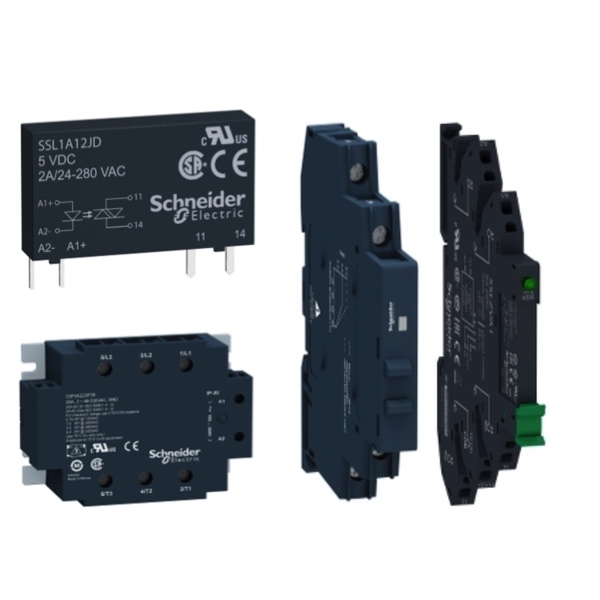Schneider Electric Solid State Relays

Solid state relays have no moving parts like electromechanical relays, but utilize electrical components and optical properties of solid state semi-conductors to perform IO switching functions and isolation. They are designed for applications that require high switching speed without arcing or contact noise. They are highly resistant to vibration and shock and are unaffected by the presence of dust, gases or other contaminants. Solid state relays are used in heating control applications for a compressor’s soft-start, fan, blower, heater and valve control. They are used in lighting applications for dimming and for their ability to operate silently and switch quickly. Because of their resistance to shock and vibration and non-arcing, motion control applications such as lifts, hoists conveyor systems and elevators are the perfect fit for solid state relays.
Schneider Electric Harmony solid state relay product range offers slim interface (SSL), modular DIN rail (SSD, SSM) and panel mount (SSP) solid state relays that provide a compact solution for a wide variety of applications.
More Information about Schneider Electric Solid State Relays
Schneider Electric Harmony SSD solid state relays have a high-power density (up to 35 A for 22.5 mm models and up to 60 A for 45 mm models) to optimize the size of enclosures. They are available in Relay and Contactor type with a spring or screw plug-in for input terminals. Output terminals include: standard screw, telescopic or clamp cage. This is the first range of Harmony Relays to comply with IEC 61373 ( for railway and rolling stock) and IEC 60947-3 (for Electromagnetic compatibility). Please note that SSD is a substitute for SSM1.
Schneider Electric Harmony SSP are single-phase and three-phase panel mount solid state relays with a range of heat sinks and accessories to meet application needs from 10 A to 125 A. The SSP1.S with smart diagnostics includes a test button for debugging, testing and commissioning, to provide a safe and reliable performance in diverse applications.
Relays: Electromechanical vs Solid State
Electromechanical relays (EMR)
Electromechanical relays (EMR) use physical moving parts to achieve the desired functionality. These moving parts include the contacts that switch between the normally open and normally closed stationary contacts in the relay. This movement is made possible by an electromagnet. When power is applied to this magnet, it will act on the movable contact causing the relay to switch. In an EMR, it is common to hear the switching sound that is represented as a “clicking” noise. This audible noise can be helpful when determining the functionality of the relay.
Solid-state relays (SSR)
Solid-state relays (SSR) use a low power, electrical signal to generate an optical semiconductor signal that will transmit and energize an output signal. When this is activated, the input optical signal will act as the switch, allowing a higher voltage signal to pass through the relays output components. The internal circuitry of a SSR is far more complex than an EMR, but there are no physical moving parts.

